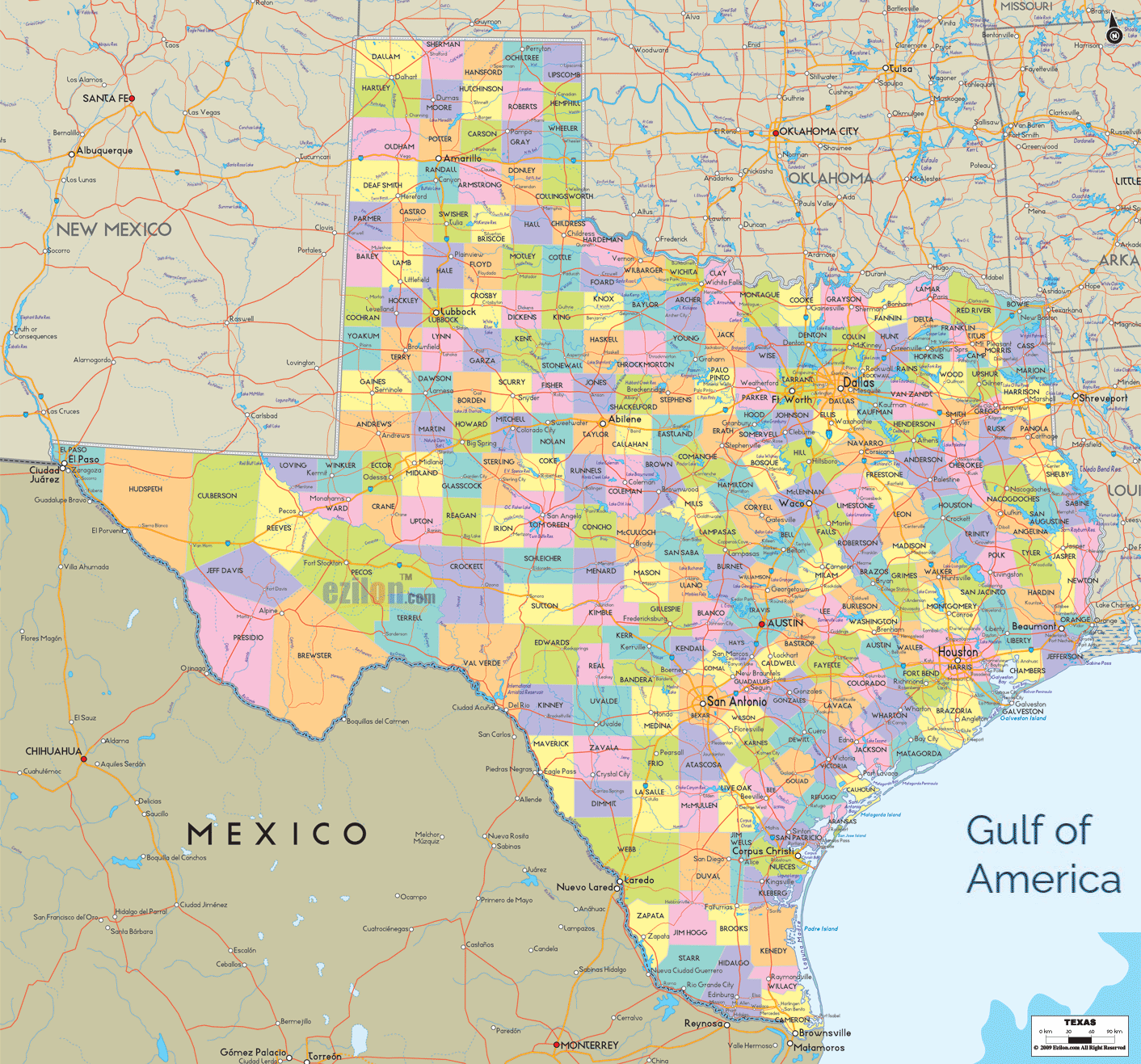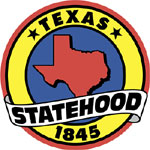

Description: Detailed large political map of Texas showing cities, towns, county formations, roads highway, US highways and State routes.
 Use this detailed map of Texas to scan all 254 counties and their respective city, each shaded distinctly with its administrative capital (county seat) and the principal cities and towns. The coastline and the borders with New Mexico, Oklahoma, Arkansas, Louisiana, and Mexico are clearly drawn, and the road-light styling keeps only the cleanest highway cues. Hence, the county grid stays front and center. This is the best map layout if you want county-first clarity while still having just enough orientation to move from region to region.
Use this detailed map of Texas to scan all 254 counties and their respective city, each shaded distinctly with its administrative capital (county seat) and the principal cities and towns. The coastline and the borders with New Mexico, Oklahoma, Arkansas, Louisiana, and Mexico are clearly drawn, and the road-light styling keeps only the cleanest highway cues. Hence, the county grid stays front and center. This is the best map layout if you want county-first clarity while still having just enough orientation to move from region to region.
Use notice: this map is for online viewing only. Printing, copying, or redistributing from our site is not permitted. Contact us for licensing if you need approved reuse.
Borders for bearings: New Mexico to the west, Oklahoma along the Red River to the north, Arkansas and Louisiana to the northeast/east, Mexico to the southwest along the Rio Grande, and the Gulf of Mexico along the southeast coast.
Rivers and basins: the Red River caps the north, the Brazos, Trinity, Colorado, Guadalupe, San Antonio, Nueces, and Rio Grande flow gulfward; the Canadian crosses the High Plains.
Road-light cues only: think of five interstate spines—I-10 (El Paso to Houston and beyond), I-20 (from the Permian Basin through Abilene to Dallas-Fort Worth), I-35 (Laredo–San Antonio–Austin–DFW–Oklahoma), I-45 (Houston to Dallas), and I-37 (San Antonio to Corpus Christi). They appear gently so the counties remain the story.
The rectangular Panhandle is a clean block of counties under the big sky.
Potter County – county seat: Amarillo, the regional anchor, with Randall County – Canyon just south; Amarillo straddles both.
North tier along Oklahoma: Sherman (Stratford), Hansford (Spearman), Ochiltree (Perryton), Lipscomb (Lipscomb), Hemphill (Canadian).
Western line with New Mexico: Dallam (Dalhart) and Hartley (Channing); below them Oldham (Vega), Deaf Smith (Hereford), Parmer (Farwell), Bailey (Muleshoe), and Cochran (Morton).
Center rows: Moore (Dumas), Hutchinson (Stinnett), Roberts (Miami), Gray (Pampa), Carson (Panhandle); farther south Castro (Dimmitt), Lamb (Littlefield), Hale (Plainview), Floyd (Floydada), Briscoe (Silverton), Hall (Memphis), Childress (Childress), Collingsworth (Wellington), Donley (Clarendon), Armstrong (Claude), Swisher (Tulia).
The Caprock transition leads into Lubbock County – Lubbock (university city), ringed by Hockley (Levelland), Terry (Brownfield), Lynn (Tahoka), Garza (Post), Crosby (Crosbyton), Dickens (Dickens), and Kent (Jayton).
East of Lubbock, the Rolling Plains include Motley (Matador), Cottle (Paducah), King (Guthrie, ranch county), Stonewall (Aspermont), Fisher (Roby), Jones (Anson), Haskell (Haskell), Knox (Benjamin), and Baylor (Seymour).
The far southeast of the Panhandle block shows Wheeler (Wheeler) on the Oklahoma line and Montague (Montague) farther east as we glide into North Texas.
Along the Red River, county seats face Oklahoma towns across the bridges: Clay (Henrietta), Wichita (Wichita Falls), Archer (Archer City), Young (Graham), Jack (Jacksboro), Montague (Montague), Cooke (Gainesville), Grayson (Sherman–Denison), Fannin (Bonham), Lamar (Paris), Red River (Clarksville), Bowie (New Boston).
The Dallas–Fort Worth Metroplex appears as a dense constellation, but the county grid still reads cleanly:
Dallas County – Dallas sits east of the Trinity fork, ringed by Collin (McKinney with Plano and Frisco), Rockwall (Rockwall), Kaufman (Kaufman), Ellis (Waxahachie), Johnson (Cleburne), Tarrant (Fort Worth), Denton (Denton), Wise (Decatur), Parker (Weatherford).
South and southwest of the Metroplex: Hood (Granbury) traces the Brazos arm of Lake Granbury, Somervell (Glen Rose), Erath (Stephenville), Comanche (Comanche), Eastland (Eastland), Stephens (Breckenridge), Palo Pinto (Palo Pinto).
North and northeast exurbs and prairies: Hunt (Greenville), Delta (Cooper), Hopkins (Sulphur Springs), Franklin (Mount Vernon), Titus (Mount Pleasant), Morris (Daingerfield).
The inland lakes pop in blue- Possum Kingdom, Ray Roberts, Lewisville, Ray Hubbard, Cedar Creek, Richland-Chambers, Navarro Mills, Waco, Belton, Stillhouse, Somerville—but the narrative stays county-first:
McLennan County - Waco centers the Brazos Valley with Bosque (Meridian) and Hill (Hillsboro) nearby.
South and east along the Blackland Prairie: Limestone (Groesbeck), Freestone (Fairfield), Navarro (Corsicana), Ellis (Waxahachie), Johnson (Cleburne), already noted, then Coryell (Gatesville) and Bell County - Belton with the metro duo Killeen-Temple.
The Big Country around Abilene shows Taylor County - Abilene, rimmed by Nolan (Sweetwater), Coke (Robert Lee), Runnels (Ballinger), Coleman (Coleman), Callahan (Baird), Shackelford (Albany), Eastland (Eastland).
Farther west, the Concho transition includes Tom Green (San Angelo) at the Concho forks with neighbors Irion (Mertzon), Sterling (Sterling City), and Crockett (Ozona) beginning the Edwards Plateau story.
The forested east is a mosaic of smaller counties with busy county seats. North to south and west to east, you’ll spot:
Wood (Quitman), Rains (Emory), Van Zandt (Canton), Henderson (Athens); south of those, Anderson (Palestine) and Cherokee (Rusk with Jacksonville).
Farther east: Smith County - Tyler at the rose capital; surrounding counties include Gregg (Longview), Upshur (Gilmer), Harrison (Marshall) on the Louisiana line, Marion (Jefferson) on Caddo Lake, Panola (Carthage), Shelby (Center), Sabine (Hemphill), and San Augustine (San Augustine).
The Neches–Angelina country: Angelina County - Lufkin, Nacogdoches County - Nacogdoches, Polk (Livingston), Trinity (Groveton), Houston (Crockett), Tyler (Woodville), Jasper (Jasper), Newton (Newton) on the Sabine border.
Farther north toward Arkansas: Cass (Linden), Bowie (New Boston), Red River (Clarksville), Lamar (Paris), and Delta (Cooper) already noted.
Along the Trinity River lower valley: Liberty (Liberty) and Chambers (Anahuac), which we connect to in Part 2 when we trace the upper Gulf Coast.
The map’s color blocks show rugged limestone counties dotted with clear rivers and spring-fed towns.
Travis County – Austin is the capital anchor on the Colorado River, with suburbs in Williamson (Georgetown, Round Rock), Hays (San Marcos, Kyle, Buda), Bastrop (Bastrop), and Caldwell (Lockhart).
Classic Hill Country counties: Burnet (Burnet), Llano (Llano), Blanco (Johnson City), Gillespie (Fredericksburg), Kendall (Boerne), Kerr (Kerrville), Bandera (Bandera).
Plateau counties stepping west: Mason (Mason), Kimble (Junction), Edwards (Rocksprings), Real (Leakey), Uvalde (Uvalde), and Kinney (Brackettville) edging toward the Rio Grande.
North side of the plateau: San Saba (San Saba), McCulloch (Brady, “Heart of Texas”), Menard (Menard), Schleicher (Eldorado), Sutton (Sonora).
Concho Valley hub Tom Green - San Angelo spreads into Irion, Sterling, Reagan (Big Lake), Crockett (Ozona); northward, the Permian Basin starts with Midland (Midland) and Ector (Odessa).
Bexar County – San Antonio anchors South Texas. Surrounding counties include Comal (New Braunfels) to the northeast, Guadalupe (Seguin), Wilson (Floresville), Atascosa (Jourdanton), Medina (Hondo), Bandera, Kendall, Kerr, and Gillespie.
Brush Country counties radiating south and west: Frio (Pearsall), La Salle (Cotulla), Dimmit (Carrizo Springs), Zavala (Crystal City), Maverick (Eagle Pass), Kinney (Brackettville), Uvalde (Uvalde).
Coastal-inland step: McMullen (Tilden), Live Oak (George West), Bee (Beeville), Goliad (Goliad) connect the San Antonio River valley toward the coast.
Rio Grande Plains along the border: Webb (Laredo), Zapata (Zapata), Starr (Rio Grande City), Hidalgo (Edinburg), with McAllen, Pharr, Mission, Cameron (Brownsville, Harlingen) lining the Lower Rio Grande Valley.
The shoreline is interrupted by bays—Corpus Christi, Matagorda, Galveston—and river mouths.
Nueces County – Corpus Christi and San Patricio (Sinton) anchor the Coastal Bend with Aransas (Rockport) and Refugio (Refugio) northward.
The barrier-island run continues through Kleberg (Kingsville), Kenedy (Sarita), and Willacy (Raymondville) to Cameron (Brownsville) on the river mouth.
Mid-coast counties: Calhoun (Port Lavaca) on Lavaca and Matagorda Bays, Victoria (Victoria), Jackson (Edna), Matagorda (Bay City), Wharton (Wharton), Colorado (Columbus) inland on the Colorado River.
Upper Coast and Houston region: Harris County – Houston dominates the upper coast, with ring counties Fort Bend (Richmond), Brazoria (Angleton), Galveston (Galveston), Chambers (Anahuac), Liberty (Liberty), Montgomery (Conroe), Waller (Hempstead). The Trinity and San Jacinto systems mark the east side, while the Brazos marks the southwest.
Northeast toward Louisiana: Jefferson (Beaumont, Port Arthur) and Orange (Orange) at the Sabine River mouth.
Between Austin and Waco, Bell (Belton) with Temple–Killeen, plus Coryell (Gatesville) and Lampasas (Lampasas); westward Brown (Brownwood) and Mills (Goldthwaite).
Southward on I-35: Comal (New Braunfels) and Guadalupe (Seguin) to Bexar (San Antonio); farther south, Atascosa, Frio, and La Salle step toward the brush country.
The colors spread thin as counties grow huge across the desert basins and mountains.
Permian Basin: Midland (Midland), Ector (Odessa), Andrews (Andrews), Martin (Stanton), Howard (Big Spring), Glasscock (Garden City), Upton (Rankin), Reagan (Big Lake), Ward (Monahans), Winkler (Kermit), Loving (Mentone)—the least populated county—Crane (Crane).
Trans-Pecos mountains and border valleys: El Paso County – El Paso against New Mexico and Chihuahua; southeast to Hudspeth (Sierra Blanca), Culberson (Van Horn), Jeff Davis (Fort Davis), Presidio (Marfa/Presidio) along the Rio Grande canyons, Brewster (Alpine)—largest county—containing Big Bend National Park, then Terrell (Sanderson), Val Verde (Del Rio) on the Amistad reservoir.
North of the river canyons: Pecos (Fort Stockton), Reeves (Pecos), Loving, and Winkler are already noted; then Eddy and Lea are in New Mexico across the line.
Far northwest of the Rolling Plains: Crockett, Sutton, Schleicher, and Kimble lead back toward the Hill Country.
We finish by sweeping the remaining east-central counties that tie Central Texas to the coast and the Louisiana line:
Brazos County - Bryan-College Station with Washington (Brenham), Austin (Bellville), and Waller (Hempstead) connecting to Houston’s northwest.
North of the big woods: Leon (Centerville), Madison (Madisonville), Grimes (Anderson); east and southeast Walker (Huntsville), San Jacinto (Coldspring), Hardin (Kountze).
Along the Neches and Sabine mouth: Tyler (Woodville), Jasper (Jasper), Newton (Newton), already mentioned; the string closes at Jefferson (Beaumont) and Orange (Orange) at the Louisiana bridge.
County-first clarity: every Texas county is color-blocked and uppercase-labeled; the seat is a solid dot so you can associate county name → seat → nearby towns at a glance.
Regional story: the layout makes Texas’s geographic regions obvious - Panhandle High Plains, Rolling Plains, Prairies and Lakes, Hill Country/Edwards Plateau, South Texas Brush Country, Coastal Plains, Piney Woods, Permian Basin, and Trans-Pecos.
Light but helpful wayfinding: a few interstates and rivers are retained to place the big hubs (Amarillo, Lubbock, DFW, Waco, Austin, San Antonio, Houston, Corpus Christi, Brownsville, El Paso) without clutter.
Texas has an area of approximately 261,232 square miles. Also, nearly 32 million people live in Texas. The state is sometimes referred to as the Lone Star State.
Although people view Texas as a Southwestern desert state, less than 110 of its land area is actually desert. People often think of cowboys and boots when they think of Texas. This is in part because Texas has been a cattle industry for a very long time.
Texas is double the size of Japan. Over two-thirds of Texas citizens are White, with Hispanic and Non-Hispanic being the two largest ethnic groups in this state. A few of the Texans originate from the English, Germans, African Americans, Asians, and Scots-Irish.

Physical Map of Texas
Physical map and map image of Texas.

Regional Directory of Canada
Information and guide about Canada and website listing.

Regional Directory of United States of America
Information and guide about United States of America and websites with American topics.

Regional Directory of Europe
Information and guide about Europe and websites with European topics.

Regional Directory of Australia
Information and guide about Australia and websites with Australian topics.